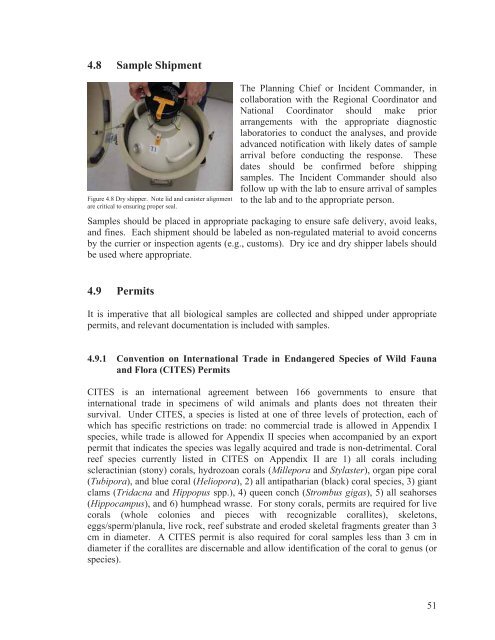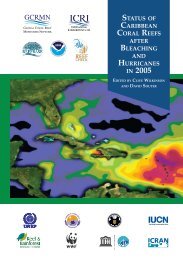Field Manual for the Investigation of Coral Disease Outbreaks
Field Manual for the Investigation of Coral Disease Outbreaks
Field Manual for the Investigation of Coral Disease Outbreaks
Create successful ePaper yourself
Turn your PDF publications into a flip-book with our unique Google optimized e-Paper software.
4.8 Sample ShipmentFigure 4.8 Dry shipper. Note lid and canister alignmentare critical to ensuring proper seal.The Planning Chief or Incident Commander, incollaboration with <strong>the</strong> Regional Coordinator andNational Coordinator should make priorarrangements with <strong>the</strong> appropriate diagnosticlaboratories to conduct <strong>the</strong> analyses, and provideadvanced notification with likely dates <strong>of</strong> samplearrival be<strong>for</strong>e conducting <strong>the</strong> response. Thesedates should be confirmed be<strong>for</strong>e shippingsamples. The Incident Commander should als<strong>of</strong>ollow up with <strong>the</strong> lab to ensure arrival <strong>of</strong> samplesto <strong>the</strong> lab and to <strong>the</strong> appropriate person.Samples should be placed in appropriate packaging to ensure safe delivery, avoid leaks,and fines. Each shipment should be labeled as non-regulated material to avoid concernsby <strong>the</strong> currier or inspection agents (e.g., customs). Dry ice and dry shipper labels shouldbe used where appropriate.4.9 PermitsIt is imperative that all biological samples are collected and shipped under appropriatepermits, and relevant documentation is included with samples.4.9.1 Convention on International Trade in Endangered Species <strong>of</strong> Wild Faunaand Flora (CITES) PermitsCITES is an international agreement between 166 governments to ensure thatinternational trade in specimens <strong>of</strong> wild animals and plants does not threaten <strong>the</strong>irsurvival. Under CITES, a species is listed at one <strong>of</strong> three levels <strong>of</strong> protection, each <strong>of</strong>which has specific restrictions on trade: no commercial trade is allowed in Appendix Ispecies, while trade is allowed <strong>for</strong> Appendix II species when accompanied by an exportpermit that indicates <strong>the</strong> species was legally acquired and trade is non-detrimental. <strong>Coral</strong>reef species currently listed in CITES on Appendix II are 1) all corals includingscleractinian (stony) corals, hydrozoan corals (Millepora and Stylaster), organ pipe coral(Tubipora), and blue coral (Heliopora), 2) all antipatharian (black) coral species, 3) giantclams (Tridacna and Hippopus spp.), 4) queen conch (Strombus gigas), 5) all seahorses(Hippocampus), and 6) humphead wrasse. For stony corals, permits are required <strong>for</strong> livecorals (whole colonies and pieces with recognizable corallites), skeletons,eggs/sperm/planula, live rock, reef substrate and eroded skeletal fragments greater than 3cm in diameter. A CITES permit is also required <strong>for</strong> coral samples less than 3 cm indiameter if <strong>the</strong> corallites are discernable and allow identification <strong>of</strong> <strong>the</strong> coral to genus (orspecies).51
















